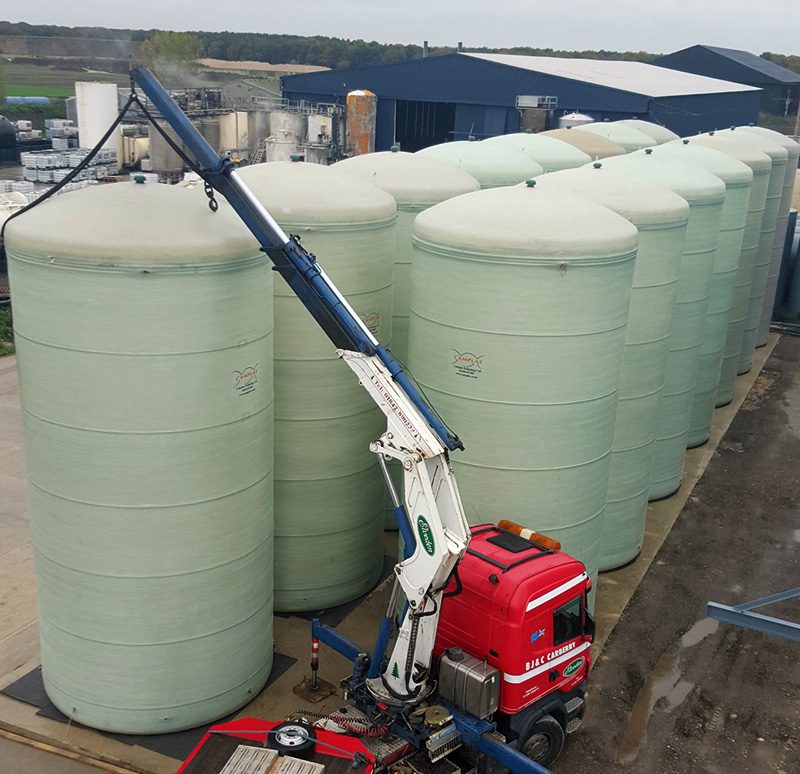A current emphasis on the environment is driving the demand for supertanks upwards from 50 m3 to 100 m3, according to Bridgend based tank supplier Camplas Technology.

Typically these larger tanks are used for storing material such as digestate (from anaerobic digestion plants), BioBlue (for removing pollutants from diesel exhausts), and environmentally friendly de-icing chemicals (for airports and military airfields).
There has also been a huge increase in demand from the water industry, particularly for the dished base version, on small sewage treatment plants under the AMP6 programme. The heavy sludge settles in the dished base and decanting valves allow the liquor to feed through into the treatment process. This increases the capacity and effectiveness of the plant without involving huge cost or disruption, says Camplas.
These are said to be particularly effective in rural areas with a large number of small plants such as in the South West of England (where South West Water have over 300 Camplas Supertanks in service – some over 30 years old).
The importance of protecting the environment also means that once a need has been established the tanks are required on site quickly. Traditionally plastic or stainless steel tanks take much longer to fabricate than Camplas tanks, according to the firm. These can seemingly be supplied at much shorter notice.
To meet this demand Camplas recently commissioned two new production lines capable of handling eight 100 m3 tanks at the same time. These lines really came into their own when a customer placed an order for twenty-one 100 m3 tanks to hold potassium acetate, an environmentally friendly de-icing chemical, in early October 2015. These tanks were required to be made, delivered and erected by the end of November. Not only was this achieved, but the customer added another five tanks to the order.
The Camplas supertanks are made from advanced composites using the firm’s Fiberlay method, a patented process employing a variable-angle helical-winding system which, unlike hoop winding, concentrates the strength in the direction of the expected stresses. This not only provides the optimum structure for large tanks but results in a one-piece vessel with no joints below the maximum liquid level and an assurance that there will be no leakage.A current emphasis on the environment is driving the demand for supertanks upwards from 50 m3 to 100 m3, according to Bridgend based tank supplier Camplas Technology.
Typically these larger tanks are used for storing material such as digestate (from anaerobic digestion plants), BioBlue (for removing pollutants from diesel exhausts), and environmentally friendly de-icing chemicals (for airports and military airfields).
There has also been a huge increase in demand from the water industry, particularly for the dished base version, on small sewage treatment plants under the AMP6 programme. The heavy sludge settles in the dished base and decanting valves allow the liquor to feed through into the treatment process. This increases the capacity and effectiveness of the plant without involving huge cost or disruption, says Camplas.
These are said to be particularly effective in rural areas with a large number of small plants such as in the South West of England (where South West Water have over 300 Camplas Supertanks in service – some over 30 years old).
The importance of protecting the environment also means that once a need has been established the tanks are required on site quickly. Traditionally plastic or stainless steel tanks take much longer to fabricate than Camplas tanks, according to the firm. These can seemingly be supplied at much shorter notice.
To meet this demand Camplas recently commissioned two new production lines capable of handling eight 100 m3 tanks at the same time. These lines really came into their own when a customer placed an order for twenty-one 100 m3 tanks to hold potassium acetate, an environmentally friendly de-icing chemical, in early October 2015. These tanks were required to be made, delivered and erected by the end of November. Not only was this achieved, but the customer added another five tanks to the order.
The Camplas supertanks are made from advanced composites using the firm’s Fiberlay method, a patented process employing a variable-angle helical-winding system which, unlike hoop winding, concentrates the strength in the direction of the expected stresses. This not only provides the optimum structure for large tanks but results in a one-piece vessel with no joints below the maximum liquid level and an assurance that there will be no leakage.






